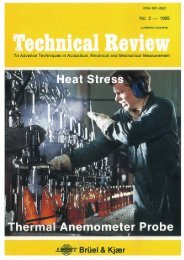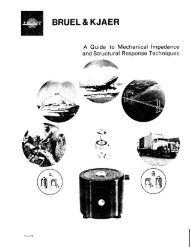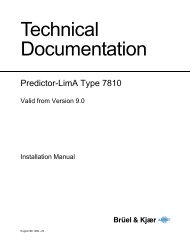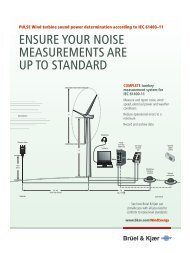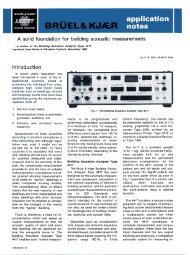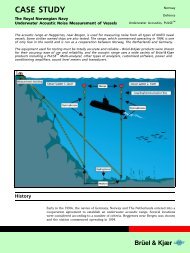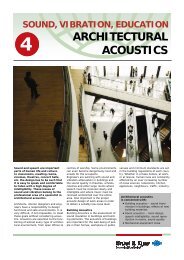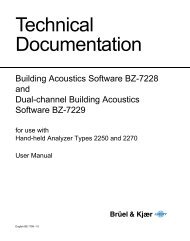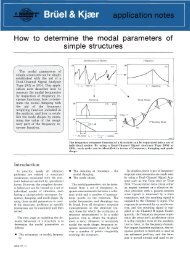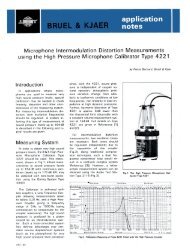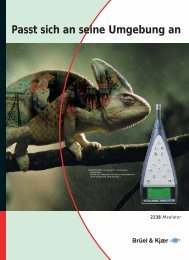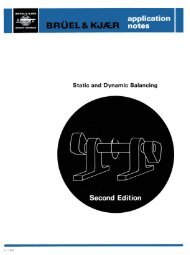Thyristors in Railway Traction How can their effects be measured?
Thyristors in Railway Traction How can their effects be measured?
Thyristors in Railway Traction How can their effects be measured?
Create successful ePaper yourself
Turn your PDF publications into a flip-book with our unique Google optimized e-Paper software.
The 2031 will also give you a<br />
very <strong>in</strong>formative picture — literally<br />
— of transients such as the <strong>in</strong>rush<br />
current on a DC chopper or AC traction<br />
transformer. It has all the facilities<br />
you would expect for versatile<br />
trigger<strong>in</strong>g, and to save you hav<strong>in</strong>g<br />
to repeat an event, it stores all the<br />
<strong>in</strong>formation about the event for as<br />
long as you want. You <strong>can</strong> display<br />
not just a precise, calibrated spectrum<br />
of the transient, but you <strong>can</strong><br />
also look at the waveform itself (us<strong>in</strong>g<br />
the 2031 as a high-quality storage-oscilloscope)<br />
and move an electronic<br />
cursor across it to make<br />
measurements of its characteristics.<br />
You <strong>can</strong> switch from one to the<br />
other at will, and decide whether<br />
the level of dangerous frequencies<br />
is enough to matter or not. You <strong>can</strong><br />
do it for as many transients as you<br />
have bothered to tape-record, with-<br />
Primary current waveform and spectra recorded at the same <strong>in</strong>stant as the lower of the two vol- OUt tak<strong>in</strong>g up hours Of valuable<br />
tage records on the opposite page. Note that all three have 0-5000 Hz frequency scales. It <strong>can</strong> time.<br />
<strong>be</strong> seen that the 11th harmonic is much more pronounced <strong>in</strong> the voltage trace than <strong>in</strong> the current<br />
trace, <strong>in</strong>dicat<strong>in</strong>q a network parallel-resonance at around 550 Hz y-^L. L I I ■ I ,<br />
y K Other features which you might<br />
want to know about the 2031 are:<br />
* 400-channel frequency resolution<br />
over eleven ranges from 0 to<br />
The <strong>be</strong>st that <strong>can</strong> <strong>be</strong> done when weak ones, to <strong>be</strong>tter than 10%, 10 Hz to 0 to 20 kHz <strong>in</strong> 1—2—5<br />
the only spectrum analyzer avail- without chang<strong>in</strong>g any of the set- sequence<br />
able is a swept-frequency analyzer t<strong>in</strong>gs. * Facilities for display<strong>in</strong>g time-averis<br />
to contrive a stationary signal by aged spectrum and difference <strong>be</strong>mak<strong>in</strong>g<br />
a tape loop of each part of <strong>How</strong> <strong>can</strong> the 2031 achieve what tween two spectra, one of which<br />
the signal, or, rather less labor- is impossible for a swept-frequency may <strong>be</strong> <strong>in</strong>putted from an external<br />
iously, by <strong>in</strong>troduc<strong>in</strong>g a B&K Type spectrum analyzer? The answer is memory such as a desktop calcu-<br />
7502 Digital Event Recorder, which that it is almost all digital <strong>in</strong> its oper- lator, or held <strong>in</strong> the 2031 's <strong>in</strong>ter<strong>can</strong><br />
perform the same function with- ation. It divides the signal up <strong>in</strong>to re- nal memory<br />
out mov<strong>in</strong>g parts. cords of manageable length, calcu- * Averag<strong>in</strong>g is user-selected, l<strong>in</strong>lates<br />
the Fourier transform of each ear or exponential, over 1 to<br />
<strong>How</strong>ever, a much faster, and record length mathematically us<strong>in</strong>g 2048 spectra<br />
more <strong>in</strong>formative analysis may <strong>be</strong> the Fast Fourier Transform algor- * Alphanumeric <strong>in</strong>dication of all<br />
performed us<strong>in</strong>g a Type 2031 Nar- ithm, and displays the transform on relevant sett<strong>in</strong>gs displayed along<br />
row-Band Real-Time Analyzer. This its screen, while the next record is the top of the 11-<strong>in</strong> low-reflect<strong>in</strong>strument<br />
will display all the har- <strong>be</strong><strong>in</strong>g stored. It is <strong>in</strong> effect a dedi- ance screen, <strong>in</strong>clud<strong>in</strong>g l<strong>in</strong>e-selecmonics<br />
you are <strong>in</strong>terested <strong>in</strong> cont<strong>in</strong>- cated digital computer. Because it tor (cursor) position and level<br />
uously, on a big, calibrated display, takes account of all the signal, it * IEC/IEEE Std. 488 <strong>in</strong>terface<br />
and you have to play the tape only <strong>can</strong> operate <strong>in</strong> real time, whereas a * Electronic graticule for parallaxonce.<br />
It will communicate through a swept-frequency analyzer <strong>can</strong> only free read<strong>in</strong>gs<br />
standard <strong>in</strong>terface with any one of a sample the signal and <strong>in</strong> fact disre- * Analogue outputs to level recornum<strong>be</strong>r<br />
of desk-top calculators, and gards most of the <strong>in</strong>formation avail- ders-and X-Y plotters: a complete<br />
<strong>can</strong> <strong>be</strong> remotely controlled from this able. The 2031 is real-time only up spectrum <strong>can</strong> <strong>be</strong> plotted out on a<br />
calculator. It <strong>can</strong> output the time- to 2kHz, but this is normally plotter such as the B&K Type<br />
vary<strong>in</strong>g spectrum on a suitable hard- enough for traction work, s<strong>in</strong>ce it 2308 X-Y recorder <strong>in</strong> 45 seccopy<br />
unit. The display is l<strong>in</strong>ear <strong>in</strong> will analyze faithfully all the har- onds, and the same goes for confrequency,<br />
so there is no bunch<strong>in</strong>g monies of 60 Hz up to the 33rd t<strong>in</strong>uous or transient time-waveof<br />
the higher harmonics where so with a 5 Hz bandwidth. forms<br />
many l<strong>in</strong>e resonances occur, and it * Can <strong>be</strong> used as a storage-'scope<br />
is logarithmic <strong>in</strong> amplitude, with a At the same time, the 2031 is a and transient recorder<br />
choice of 20, 40 or 80dB (x10, remarkably compact <strong>in</strong>strument. It * Power requirements 100—240V<br />
x100, x 10000) full scale deflec- is all conta<strong>in</strong>ed with<strong>in</strong> a s<strong>in</strong>gle case 50—60 Hz, 1 20W approx.<br />
tion, so you <strong>can</strong> measure the ampli- weigh<strong>in</strong>g 22 kg (48,5 lb) and may<br />
tude of any harmonic, even the <strong>be</strong> used on site if required.<br />
13



